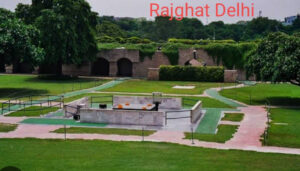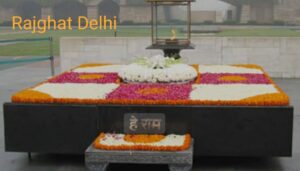Rajghat Delhi, located in the heart of Delhi, is one of the most significant memorials in India. It serves as the final resting place of Mahatma Gandhi, the father of the nation. This serene and beautifully maintained site is not only a memorial but also a symbol of peace, non-violence, and the enduring legacy of Gandhi’s teachings. In this blog post, we will explore the rich historical background of Rajghat, the architectural marvel of Gandhi’s memorial, practical visiting information, surrounding attractions, and its cultural significance. Let’s embark on this journey to understand the essence of Rajghat.

1.Rajghat, Delhi: Historical Background
Rajghat has deep historical roots that connect it to the life and legacy of Mahatma Gandhi. After Gandhi’s assassination on January 30, 1948, a decision was made to create a memorial in his honor. The site was chosen at Raj Ghat, situated on the banks of the Yamuna River. It was officially inaugurated on January 31, 1948, just a day after his death.
The memorial is built on the site where Gandhi was cremated. It symbolizes the profound impact he had on India and the world. Over the years, Rajghat has witnessed various significant events, including commemorations on Gandhi Jayanti (October 2) and ceremonies attended by dignitaries from across the globe.
2.The Memorial of Mahatma Gandhi
At the heart of Rajghat lies the memorial of Mahatma Gandhi, designed with a unique simplicity that reflects his life and philosophy. The memorial consists of a black marble platform that marks the spot of Gandhi’s cremation. This platform is surrounded by a serene garden adorned with trees and flowering plants, providing a tranquil atmosphere for reflection.
The architecture of the memorial is minimalist, embodying the principles Gandhi stood for—simplicity and humility. An eternal flame, symbolizing his everlasting spirit, burns near the memorial. The flame serves as a reminder of his teachings on peace and non-violence.
Visitors can also find inscriptions of Gandhi’s thoughts and quotes engraved on the walls surrounding the memorial, further enhancing the significance of this sacred place. The simplicity of the design emphasizes that Gandhi’s legacy is not in grandeur but in the profound impact he had on millions.

3.Visiting Rajghat
For those planning to visit Rajghat, there are several practical details to keep in mind. Located in central Delhi, Rajghat is easily accessible via various modes of transportation. The nearest metro station is the Delhi Gate Metro Station, which is a short drive away. Visitors can also opt for auto-rickshaws or cabs, which are readily available.
Rajghat is open to the public from sunrise to sunset, making it convenient for visitors to plan their trip. There is no entry fee, allowing everyone to pay their respects. The best times to visit are early in the morning or late in the afternoon, when the temperatures are pleasant, and the light is perfect for photography.
While visiting, it’s important to maintain decorum as Rajghat is a solemn site. Visitors are expected to observe silence, dress modestly, and refrain from taking photographs in certain areas, particularly around the memorial.
4. Surrounding Attractions
Rajghat is not only a memorial but also a gateway to exploring other significant sites in the vicinity. A short distance from Rajghat, you can find the Samadhis (memorials) of other prominent leaders, including Jawaharlal Nehru and Sardar Vallabhbhai Patel. These memorials provide insight into the contributions of various leaders in shaping India’s history.
The Mahatma Gandhi Museum, located nearby, offers a deeper understanding of Gandhi’s life, philosophy, and the Indian freedom struggle. Visitors can explore photographs, artifacts, and personal belongings of Gandhi, making it a must-visit for history enthusiasts.
For those looking to relax, Lodhi Gardens, a picturesque park, is just a short drive away. The gardens feature beautiful tombs, lush greenery, and serene pathways, perfect for a leisurely stroll after visiting Rajghat.
If you’re planning a day trip, consider combining your visit to Rajghat with these nearby attractions to make the most of your experience in Delhi.

5.Cultural Significance
Rajghat holds immense cultural significance in contemporary India. It is not just a memorial; it is a site for commemorative events and ceremonies that reflect the nation’s respect for Gandhi’s ideals. Every year, on Gandhi Jayanti, millions gather at Rajghat to pay their tributes. Dignitaries, including the President and Prime Minister, often lay wreaths at the memorial, reinforcing its importance in national identity.
Rajghat also serves as a venue for peace rallies and social justice events, symbolizing Gandhi’s enduring influence on social movements. It is a place where people come together to reflect on Gandhi’s teachings of non-violence, truth, and equality.
The cultural relevance of Rajghat extends beyond India. It attracts tourists, scholars, and activists from around the world who seek inspiration from Gandhi’s philosophy. This international recognition of Rajghat emphasizes its role as a symbol of peace and reconciliation.
6.Photography and Art at Rajghat
Rajghat offers a myriad of opportunities for photography enthusiasts. The tranquil surroundings, well-manicured gardens, and the iconic black marble memorial create a picturesque setting. Here are some tips for capturing the beauty of Rajghat:
1. Golden Hour Photography: Visit during sunrise or sunset for soft lighting that enhances the memorial’s beauty.
2. Focus on Details: Capture close-up shots of inscriptions, flowers, and the eternal flame to convey the memorial’s emotional depth.
3. Wide-Angle Shots: Use a wide-angle lens to capture the expansive gardens and the layout of the memorial.
In addition to photography, Rajghat has inspired numerous artists, writers, and filmmakers. The site serves as a canvas for artistic expressions that convey the essence of Gandhi’s life and teachings. From paintings to sculptures, the memorial has become a source of inspiration for creativity.
Visitors often leave behind their thoughts and feelings in the form of messages, poems, or drawings in the visitor’s book. This artistic expression creates a sense of community and shared reverence for Gandhi’s legacy.
7. Environmental Aspects
Rajghat is not only a historical site but also a model for environmental sustainability. The surrounding gardens are meticulously maintained, contributing to the green landscape of Delhi. The memorial emphasizes the importance of preserving nature alongside historical heritage.
Efforts are made to keep Rajghat clean and free from litter. Visitors are encouraged to be responsible and practice eco-friendly behavior while enjoying the serene environment. The importance of preserving such historical sites for future generations is crucial, and Rajghat stands as a testament to that commitment.
Moreover, the surrounding greenery provides a habitat for various bird species, making it a haven for nature lovers. Birdwatching can be a delightful addition to the visit, allowing guests to appreciate both the cultural and natural beauty of Rajghat.
Conclusion:
Rajghat Delhi, stands as a powerful reminder of Mahatma Gandhi’s profound impact on India and the world. The memorial not only pays tribute to his legacy but also serves as a place of reflection, peace, and cultural significance. Visiting Rajghat offers an opportunity to connect with history, honor the principles of non-violence, and appreciate the beauty of the surrounding environment.
As you plan your visit to Delhi, make sure to include Rajghat in your itinerary. Whether you are a history buff, a peace advocate, or simply looking for a serene place to reflect, Rajghat has something to offer everyone. Share your experiences and thoughts about Rajghat in the comments below and help preserve the memory of this iconic site.
FAQs:
1.What is the Raj Ghat famous for?
2.Can normal people visit Raj Ghat?
3.Which day is Raj Ghat closed?
4.Is food allowed in Raj Ghat?
5.Where is Rajghat located
6.Rajghat Delhi nearest metro station
7.Raj Ghat is the samadhi of
8.What is the importance of Raj Ghat
9.Raj Ghat area
10.Who built Rajghat

